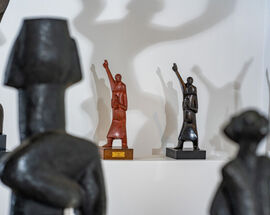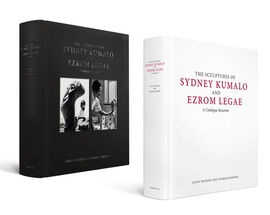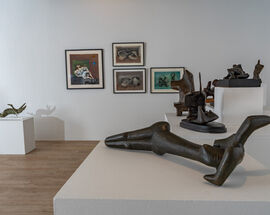
South Africa’s history is riddled with suffering, inequality and displacement because of the racially discriminatory apartheid system that began in 1948 and was abolished in 1994. During that time, many resistance movements were formed to push back against the regime, and these gained international attention and support, as they gave a voice to and documented the human rights atrocities being committed. However in South Africa, other stories were unfolding that never made the headlines.
One of these was the work of many black artists working during the height of apartheid, that went largely undocumented; many remain unknown and their contribution to the local and international art landscape unspoken.
In a quest to shed light on South Africa's hidden art history, art specialist Wilhelm van Rensburg has curated a tribute exhibition for Strauss & Co, entitled A Retrospective Exhibition, that explores the work of South African sculptors Sydney Kumalo and Ezrom Legae. It's an incredible catalogue of the work of these two artists, with many of the pieces having been sourced from private collections for this exhibition. It's a spectacular sight.
If it’s your first time hearing these names, it’s understandable. Their work was largely produced during apartheid and has been buried in art archives for years, making this exhibition important to South African history and to a greater understanding of contemporary African art.
“Until very recently, these two artists would have been classified as 'township artists' or 'resistance artists', or what they call a 'neglected tradition'. We felt they are more than those terms. It’s really challenging the history of South African art not to label them so easily, but we also wanted to challenge global art history,” Van Rensburg shares.
For van Rensburg, Kumalo and Legae were at the centre of the Modernist movement in both the local and international art landscape.
“They were at the forefront. In the 1930s and 1940s, many artists went to Paris or London and came back with the latest trends, but these artists never had the opportunity to do so, which didn’t mean that they weren’t important. Some of the figures they created were shown internationally, so they eventually got that exposure,” he says.
Born in 1935, Kumalo’s art journey began while studying at Polly Street Art Centre in Johannesburg. Here, he was taught by prominent artist Cecil Skotnes, who contributed greatly to the development of black creatives. In 1964, Kumalo became a professional artist, and he was known for creating metal figures and sculptures. He went on to become one of the pioneers of Afrocentric art, which gave voice to the anger experienced by many South Africans during apartheid. Born in Soweto, he passed away in 1988.
Like Kumalo, Legae also studied at Polly Street, where he created sculptures and later moved into drawing. Legae's work involved powerful social and political commentary, and became recognisable for its focus on heads and animals. “Many of these artists, like Legae, used animals as metaphors for the inequalities of apartheid,” remarks van Rensburg.
A product of its time, Legae’s work reflected the sadness, tragedy, and impact of apartheid. The sculptor died in 1999, and he spent his last years exploring the persistence of poverty and racism in post-apartheid South Africa.
“If I had my way, every school child would learn a bit of art history," says van Rensberg. "Education about South African artists like Kumalo and Legae is important because they have become classical. They are part of the world's heritage and culture, and the younger generation can now be inspired by their work."
We asked curator Wilhelm van Rensburg for some additional information about this exceptional exhibition and the process that went behind it.
How long did it take to conceptualize this exhibition?
The Sydney Kumalo and Ezrom Legae retrospective exhibition is the latest in a series of annual legacy exhibitions mounted by Strauss & Co, started in 2019 with pairing Louis Maqhubela & Douglas Portway; in 2020, Gladys Mgudlandlu and Maggie Laubser; in 2021, George Pemba and Robert Hodgins, and in 2022, Mary Sibande and Dorothy Kay. The main focus of these legacy exhibitions is on education, and Strauss & Co hosts many school groups and organizes pre-and in-service teacher training workshops, amongst many other educational events during the run of the shows.
Conceptualizing a large-scale retrospective exhibition has to take into account the breadth and depth of the work of an artist, and the research usually takes quite a long time. As a curator, one has to take into consideration the exhibition space at one's disposal and the availability of the works one wants to showcase as well.
Where did the process start?
The process, in this case, started with the publication of the Catalogue Raisonne of the sculptures of Sydney Kumalo and Ezrom Legae. The compilers of the Catalogue, Gavin Watkins and Charles Skinners listed 125 Kumalo works, of which 60 are on exhibition, and 55 unique images by Legae, of which there are 32 on display.
You have assembled an incredible collection of works. Where do these come from?
As a matter of principle, I make a point of extending loan requests to the museums and galleries of South Africa, and I am grateful to say that Pretoria Art Museum, Durban Art Gallery, Iziko South African National Gallery, Rupert Museum in Stellenbosch, the Norval foundation, and Wits Art Museum were very generous in their loan agreements. In addition, I was also very fortunate to have seminal works from the Reserve Bank art collection and the Standard Bank Corporate Art collection on exhibition. And of course, from large private collections as well.
Can you share the process of sourcing the works?
The process starts with extending loan requests to potential lenders, which includes motivation for the inclusion of a work in the exhibition. Willing lenders usually then issue a loan agreement. The next step would be to obtain insurance certificates for the works, provide a facilities report, including the security arrangements, and finally, arrange the logistics to get the works to the display venue.
What were the key issues you kept in mind when curating this exhibit?
A retrospective exhibition gives an overview of the breadth and depth of an artist, and a curator has to ensure that the best examples are on show. It was not possible to arrange these works chronologically, because one is not always completely sure of when exactly a particular sculpture was actually case. In addition, I didn’t want to separate the works of these two sculptors in the space, because there is such a great synergy between them and their works speak to one another so brilliantly. Therefore, the best way for me was to arrange the works according to subject matter and theme. So, there s a wonderful section of equestrian figures, a section on reclining nudes, on mother-and-child, and on seated and standing woman figures.
Why was it essential for you to combine a book with this exhibition?
The exhibition naturally exemplifies the contents of the book, and the talks program and teachers' workshops enrich the whole experience of reading the book.
What role did Khumalo and Legae play in South African art history and the global art landscape?
Kumalo and Legae were the leading exponents of what is known in global art history as early black modernists, following directly in the footsteps of Gerard Sekoto and Ernest Mancoba. They exemplified the difficulties black artists experienced in South Africa when they wanted to embark on tertiary studies in art. That is why the Polly Street Art Centre played such an important role in the education of these two sculptors who both studied there and who both became teachers at the Centre later on. At the centre, they were part of an international melting pot of inspiration; Cecil Skotnes, the founder, was of Swedish extraction, Fred Schimmel, a tutor, was Dutch, Edoardo Villa, a fellow sculptor, was Italian and Egon Guenther, the gallerist who put both Kumalo and Legae and the map, was German. Guenther was also instrumental to expose these two internationally in Rome, Venice, and Milan. Both sculptors traveled to the US and to Europe in the 1960s and 70s on grants and scholarships as well. Their work ranks amongst the best in the world, holding their own against such illustrious sculptors as Henry Moore, Barbara Hepworth, and Kenneth Armitage.
What would you say is distinct about these two artists, from the perspective of today?
The most important aspect for me certainly is the fact that these two sculptors paved the way for what is known today as Contemporary African Art. Not only in form but also in subject matter, they laid the foundation for a succession of modern and contemporary artists to explore the current state of affairs in the world in and through their art.
The Sydney Kumalo and Ezrom Legae tribute exhibition feature walkabouts every Wed until Jul 19 between 11:00 – 12:00 by Strauss & Co. specialists, plus a programme of talks. See the full line-up here. The exhibition has also been accompanied by the publication of a magnificent new book on the work of these two artists.





Comments